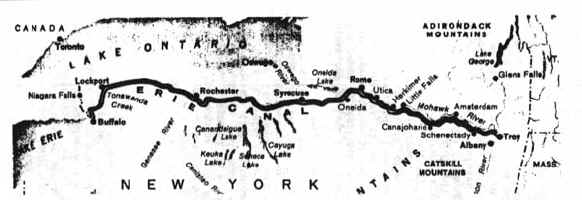 Article taken from "Backsights"
Magazine published by Surveyors Historical Society
Article taken from "Backsights"
Magazine published by Surveyors Historical Society |
THE
BUILDING OF THE ERIE CANAL
by
Mary M. Root
In 1816, the people of New
York City were worried about their economy. Baltimore and Philadelphia
were reaping the gains of the westward expansion. Their accessibility to
the Mississippi-Ohio river system via turnpike was the gateway to western
settlement. This was crucial. It was estimated that four horses
could pull one ton 12 miles a day over an ordinary road and 18 miles over a good
turnpike, but they could haul 100 tons 24 miles by water in the same period.
Speed and economy appealed to the settlers faced with moving their families and
possessions vast distances. New Yorkers mulled the problem over and 1817
approved the building of the Erie Canal from Albany to Buffalo.
The Erie project raised
the standards of canal-building, and was thus nicknamed the "Erie School of
Engineers". Many of the tools and methods they used were devised as
the work progressed. The men responsible for the design, layout and
execution of the canal were amateurs. Judge Benjamin Wright was appointed
chief engineer and James Geddes; a lawyer who had made a preliminary survey of
the canal's route, was named assistant chief. They drew about them a
number of very talented young people, among whom were John Sullivan, John
Jervis, Frederick Mills, Nathan Roberts and Canvass White. This group went
on to become the foremost canal-builders of the day. When they signed on,
they knew how to survey with the compass, level, and chain, but were in no sense
engineers. Profiting by experience, in a few years they were recognized as
the country's foremost hydraulic engineers.
 Wright
and his assistants completed the survey of the Erie's route in the spring of
1817 and established the official length at 363 miles; the descent from Lake
Erie was measured at 555 feet. Two-way traffic was to be achieved by
installing eighty-three locks; twenty-seven of them in the first fifteen miles
between Albany and Schenectady around the Cohoes Falls. The work was to be
done using horses, mules, wagons, wheelbarrows, hand tools, and thousands of
Irish laborers. Wright
and his assistants completed the survey of the Erie's route in the spring of
1817 and established the official length at 363 miles; the descent from Lake
Erie was measured at 555 feet. Two-way traffic was to be achieved by
installing eighty-three locks; twenty-seven of them in the first fifteen miles
between Albany and Schenectady around the Cohoes Falls. The work was to be
done using horses, mules, wagons, wheelbarrows, hand tools, and thousands of
Irish laborers.
Ingenuity also played its
part. They invented the stump-puller, an ingenious device that enabled six
men and a team of horses to pull and remove thirty to forty stumps in a day.
Another timesaver they devised made it possible for one man to fell a tree by
attaching a cable to the top and winding it up on an endless screw.
Instead of wearing out a team bucking brush, they made the going easy by adding
a horizontal cutting bar to the plowshare. Work proceeded faster than
ever.
Canvass White had been
sent to England to study their canals and locks. When he returned, he
brought with him new instruments, a sheaf of carefully rendered drawings, and a
better knowledge of canal construction - especially locks - than any other man
in America possessed. Armed with this knowledge, the surveyors/engineers
were able to design and build locks, dams and bridges that were widely copied on
subsequent projects.
The work was completed in
1825. Cannons had been placed every ten miles along the route. To
signal the opening, they were fired in succession, taking eighty minutes to
traverse the route from Albany to New York City. Soon they would have even
greater cause to celebrate: the canal paid for itself within two years,
and brought prosperity to every town along its path. As a tribute to
Wright and his assistants it was written: "They have built the
longest canal in the world in the least time, with the least experience, for the
least money, and the greatest public benefit".
|
